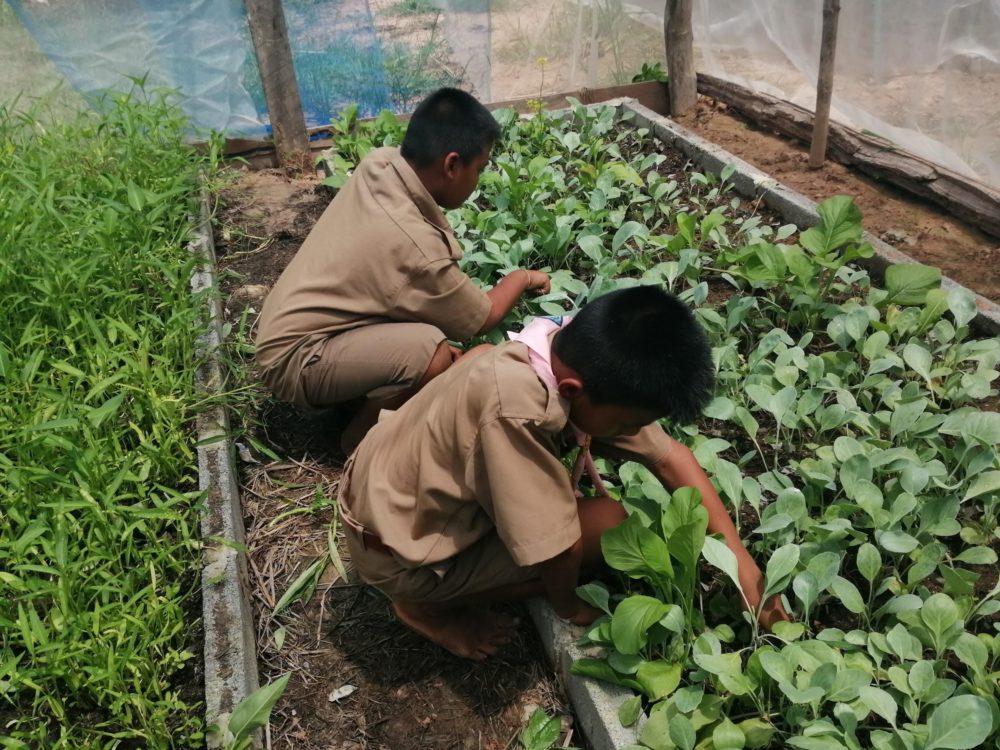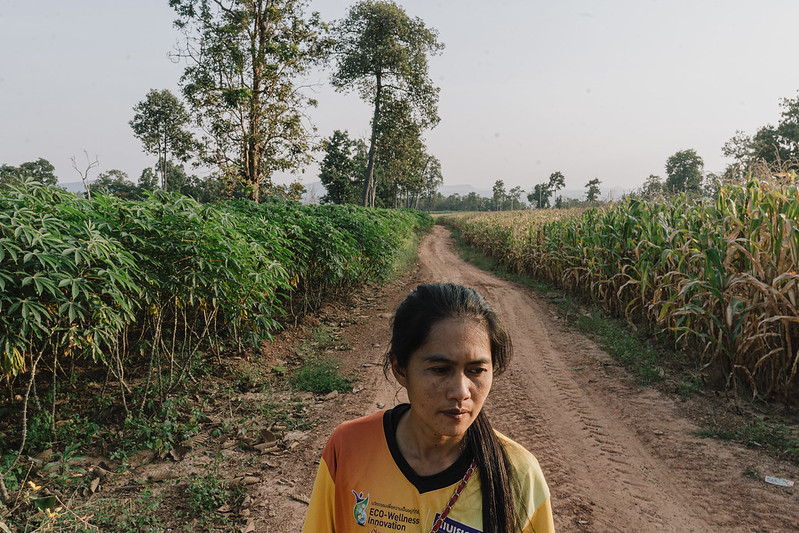Guest contribution by Samanachan Buddhajak
As much of the world’s agriculture seems hopelessly locked into chemical use, toxic residue has made it into all parts of the food chain, even finally reaching its way into the school lunches of children.
“We can’t afford to wait for the government to act,” says Uthai Kaewkla, as he leads a tour of an organic vegetable growing operation in Kalasin province’s Khongchai district in central Isaan.
The organic garden in the Khongchai Pattana sub-district belongs to the Pan Boon (“Sharing Grace”) group that locals formed after almost 100 percent of the vegetables used to cook school lunches in the district were found to be contaminated with common pesticides. Further medical testing also found unacceptable levels of toxins in the blood of many locals.
Uthai’s mission is to encourage farmers and smallholders in the district to grow organically. With currently over 40 members, Pan Boon provides organic growers with know-how and guidance while also collects their produce for wholesale distribution.
A former NGO worker, Uthai works as the chairman of the Kalasin provincial administration council and the chairman of the provincial education development council. But he is most passionate about his role as consultant to the Pan Boon group and has become the main driving force behind the push for farmers in Kalasin to switch to organic farming.

The organic vegetables grown by the Pan Boon project are sold at supermarkets in Kalasin and nearby provinces.
When the food isn’t safe for the children
“They buy cheap stuff from the market to make kids’ school lunch,” says Uthai. “Nobody really knows where these vegetables come from. It’s really hard to track down the source, who grew it, how they grew it.”
Kalasin is a province that has made a home for itself at the bottom of the Ministry of Education’s list for student performance, and Uthai believes the behavior and academic performance of schoolchildren are affected by the nutrition they’ve received, among many other factors.
Even though more children in Thailand have access to free school meals than ever before, Uthai still questions whether these meals are adequately safe and nutritious.
“Good food is crucial for the physical wellbeing of the children. They need to be eating the right food,” he says. “We’re talking about physical, cognitive, and behavioral development here.”
The need for governments and private sector organizations to work together to protect children from the harmful effects of pesticides is underscored in a 2018 UNICEF report, “Understanding the Impacts of Pesticides on Children,” which points out that children disproportionately suffer from the effects of pesticide use.
The report says that children are especially vulnerable to pesticides. Because children ingest more than adults relative to their body weight while at the same time their livers and kidneys cannot as effectively “remove pesticides,” the same amount of a chemical residue “is likely to be 10 times more toxic to a child than to an adult.”
The same report says the Thai Pesticide Action Network (Thai-PAN) found in 2016 that “residues of multiple hazardous pesticides that are banned in Thailand on fruits and vegetables in local markets and supermarkets at rates ranging from 35 per cent up to 100 per cent.” The network also found that chlorpyrifos, a pesticide widely used in agriculture produced by the US-based Dow Chemical Company, is the second most common contaminant in Thailand’s fruit and vegetables.
The Thai Education Foundation conducted a study in 2018 which collected fruit and vegetable samples from 34 schools in four provinces; 21 schools in Chiang Mai, two schools in Pathum Thani, six schools in Sakon Nakhon, and five schools in Phang Nga. From the 355 samples collected, 210, or 63 percent, were found to be unfit for consumption due to the chemical residue levels. Testing of chemical residue levels in 6,495 teachers and pupils from these schools revealed that 21 percent were at risk of illness from the chemicals present, and seven percent had unsafe levels of toxins in them.
Several studies point to chemical residue in food affecting the cognitive development of children. One such study by Columbia University in the US found that delayed development of motor and mental skills is common in children exposed to chlorpyrifos..
Reclaiming food safety for school children
This year Uthai has been pushing schools in and around his community to use organic produce in their school meals. The Pan Boon group is also encouraging and supporting schools to grow organic food for canteen meals themselves. For schools that don’t have enough land, the group sources organic produce from within its network to ensure that the school kitchens can be pesticide-free.
“There’s really not much awareness about this,” Uthai says. “Nobody seems to know or care about how important a safe, clean, diet is for child development. That’s why we felt compelled to step in.”.
Pan Boon’s organic school-meal program currently involves four schools in the area, Uthai explains. At first, schools still had to buy produce to meet their needs, but in the long run all were able to become self-sufficient, given enough space.
However, the Thai Education Foundation found that many schools in Thailand lack the space to grow their own produce and are unable to purchase organic produce from readily available sources, such as local markets.
They also found that there is very little awareness of the dangers of pesticides among schools.
School meals are often provided by commercial caterers whose suppliers and food sources are not vetted by the schools. In many areas, there is no organic produce available at all. In fact, it was found that much of the contaminated produce did in fact come from the communities surrounding the schools.
Denmark provides a clear example of how policy can support the use of organic produce, resulting in over 90 percent of Copenhagen’s schools being able to provide organic school meals. A sign of success is that the organic-only policy has now spread to the kitchens of Denmark’s public hospitals and military bases.
Apart from providing school children with nutritious, pesticide-free food, this policy has bolstered demand for organic produce in general. By creating a large, ready, and steady market for organic produce in the public sector, Denmark makes it easier and less risky for farmers to switch to organic farming. The country’s agricultural industry is now the most organic in the world.
Although the Thai government approved the increase of the primary school meal budget per pupil from 13 baht to 20 baht in 2013, organic school meals are still a distant dream for many school children. Organic produce is still too expensive for schools to buy on the market, and is simply not available in most communities.
Uthai concedes that this problem is intertwined with the way most of Thailand’s farms operate, which is mostly commercial and chemical-intensive. The relatively miniscule supply of organic produce keeps prices high.
Global food security at risk
Currently, much of the agriculture in the world takes the form of industrialized monocropping. The cultivation of a single crop across vast tracts of land brings with it many problems, such as a lack of biodiversity, deforestation, pollution, and the use of highly toxic pesticides and herbicides.
The increased use of chemicals in agriculture is a major factor in placing 40 percent of the world’s insect species under threat of extinction. In fact, they are becoming extinct at a rate of 2.5 percent per year. This is eight times higher than the rate of extinction for mammals, winged animals, or reptiles. Much of this loss is due to the heavy use of chemicals in conventional agriculture.
Aside from making pesticide use all but mandatory, monocropping is also a major contributor to soil quality depletion and erosion. The UN Convention to Combat Desertification states in a report that much of global agriculture is essentially “extractive” and as much as 20 percent of the world’s cropland is seeing falling productivity due to soil degradation.
The UN’s Food and Agriculture Organization (FAO) estimates that if we continue like this, the earth’s agriculture will only be good for another 100 harvests. In a report which collected information from 96 countries, the FAO found that the damage to biodiversity caused by monocropping is actually damage the world’s food production capacity.
The loss of biodiversity threatens food security on a global scale. Food is currently being produced from just a few different species of plants and animals. There are around 6,000 species of plants in agricultural cultivation by humans, but two-thirds of the world’s food production comes from just nine species. As for animals, our livestock generally comes from just 40 species.
Withoon Lianchamroon, director of the BIOTHAI Foundation which supports alternative agriculture, says that there is still hope for the world.
He observes that there is a growing trend towards sustainable and alternative forms of agriculture in developed countries in the Americas and Europe, as these countries have already experienced and learned from the dire effects of chemical-intensive monocropping.
“We’re starting to see some countries put a lot of effort into eco-agriculture–that’s agriculture which complements and preserves the local ecology–such as Denmark and Sweden. These two countries actually plan on doing 100 percent this way, and they’re currently ten percent of the way there.” says Withoon.
But Thailand still has a long, long way to go. Withoon points out that Thailand currently has around 300,000 rai (48,000 hectares) of alternative farming, a mere 0.02 percent of the 150 million rai (24 million hectares) of Thailand’s total agricultural land..
A report from the Paris-based think tank, the Institute for Sustainable Development and International Relations (IDDRI), states that environmentally friendly farming methods can be just as productive as the more common current intensive, chemical-laden method. The report cites studies which found, contrary to popular belief, that organic farming methods are not only able to equal the output of chemical-based agriculture, but may in fact surpass it in output with further development.

Saengchan Phonruang is one of the farmers in Khonchai district who switched to organic farming.
Model farmers
The monocropping farms doused in chemicals are undoubtedly insect-free, and their produce is visually appealing, just as the market demands. Yet, there are still some farmers who are turning their backs on that path and are moving towards organic agriculture instead.
“They say it’s slow. They say there’s nobody to do the work because my children have all gone to work in the city,” says Saengchan Phonruang, a farmer in the village of Ban Don Khaen. She switched to organic farming while her neighbors are still using chemicals.
Saengchan is adamant that organic farming is economically viable because of the lower costs. She spends no money on chemical pesticides or fertilizer. Her only problem is that her organic farm is still small scale. Without the economies of scale of her neighbors’ farms, the only customer willing to pay her asking price for organic produce is a far-away supermarket.
The best way to keep contaminated food away from children is to grow organic produce for school meals within the school itself.
Sanit Srilamphai, director of Thonburi-Khoksi-Nongtao Wittayayon School in Kalasin, says they used to have an allotment for growing vegetables in the school before, but nobody ever took it seriously. After becoming the school’s director in 2016, Sanit decided to put the allotment to good use, and the school now grows over ten different types of vegetables to feed its 144 pupils.

Students weeding a vegetable patch at Thonburi-Khoksi-Nongtao Wittayayon School in Kalasin, one of the pilot schools for the organic school lunch project.
“We have a budget of 20 baht per head which we now spend entirely on protein such as meat and eggs. We don’t pay anything for our vegetables,” Sanit says. He goes on in detail about how the children will be able to use the practical knowledge and experience in growing crops and managing the allotment as career capital in the future, given the growth of the market for organic produce.
About one kilometer away from the school lies a 32-rai organic farm with 40 greenhouses arranged in rows. They were erected when Sanit’s and ambition outgrew the school allotment and he decided to get other people involved in his vision. The upkeep, management, labor, and produce of this facility are shared between the school, the village cooperative enterprise, and a handful of other small-scale farmers. Together, they form fairly large alliance of over 100 members.
“In the beginning there were just ten others,” says Thongdee Nachaisit, the head of the village cooperative enterprise. “When other people saw that it really worked, that we could really do it, they steadily trickled in. We have members who take what they learned here and put it into practice on their own land,” he says, adding that the funding for enterprise came from the villagers, with some of the equipment donated by government agencies.
Aside from economic factors, Thongdee is also mindful of the health benefits. After members switched to organic farming, blood tests have revealed that the chemical residue in their bodies is gradually falling.
This program is an example of how a focal point of the community, such as a school, can be the starting point for positive change that radiates out into the surrounding community. Micro-level beginnings can lead to macro-level changes in the future.





